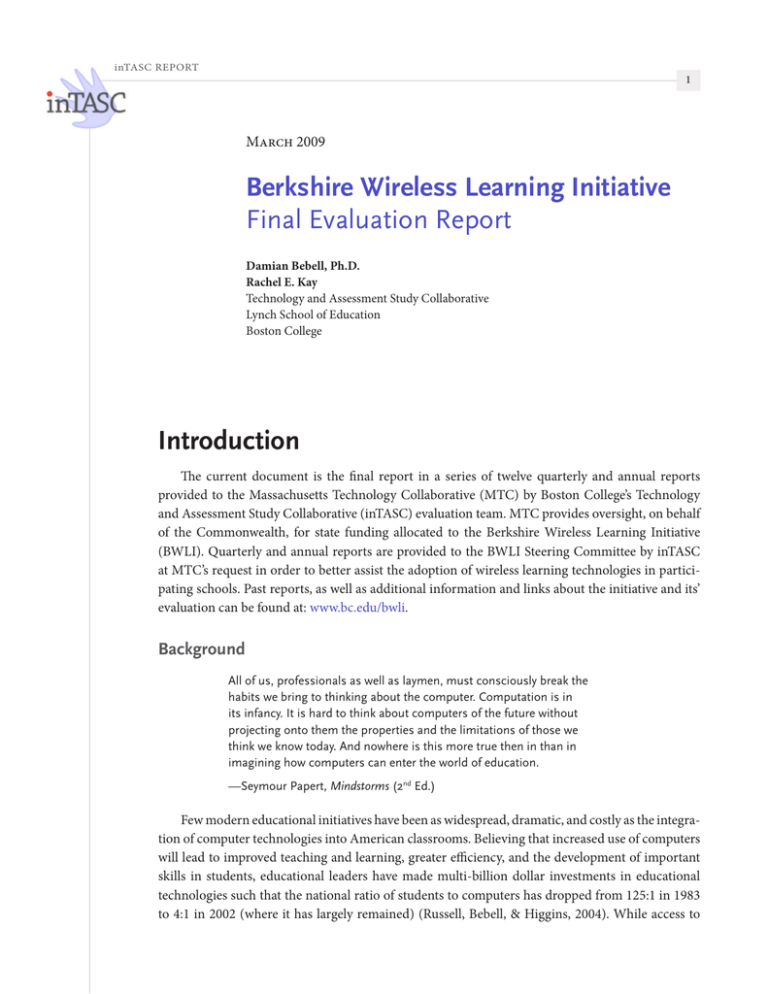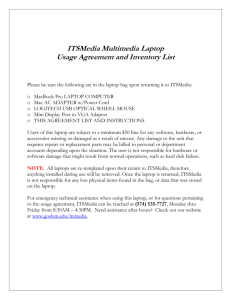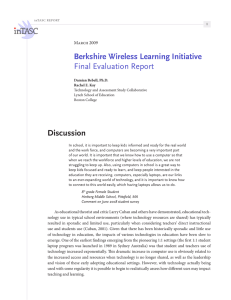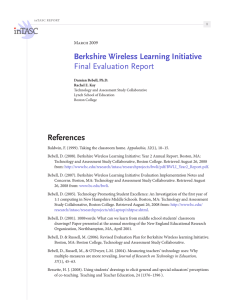Introduction Berkshire Wireless Learning Initiative Final Evaluation Report March 2009
advertisement

inTASC REPORT 1 March 2009 Berkshire Wireless Learning Initiative Final Evaluation Report Damian Bebell, Ph.D. Rachel E. Kay Technology and Assessment Study Collaborative Lynch School of Education Boston College Introduction The current document is the final report in a series of twelve quarterly and annual reports provided to the Massachusetts Technology Collaborative (MTC) by Boston College’s Technology and Assessment Study Collaborative (inTASC) evaluation team. MTC provides oversight, on behalf of the Commonwealth, for state funding allocated to the Berkshire Wireless Learning Initiative (BWLI). Quarterly and annual reports are provided to the BWLI Steering Committee by inTASC at MTC’s request in order to better assist the adoption of wireless learning technologies in participating schools. Past reports, as well as additional information and links about the initiative and its’ evaluation can be found at: www.bc.edu/bwli. Background All of us, professionals as well as laymen, must consciously break the habits we bring to thinking about the computer. Computation is in its infancy. It is hard to think about computers of the future without projecting onto them the properties and the limitations of those we think we know today. And nowhere is this more true then in than in imagining how computers can enter the world of education. —Seymour Papert, Mindstorms (2nd Ed.) Few modern educational initiatives have been as widespread, dramatic, and costly as the integration of computer technologies into American classrooms. Believing that increased use of computers will lead to improved teaching and learning, greater efficiency, and the development of important skills in students, educational leaders have made multi-billion dollar investments in educational technologies such that the national ratio of students to computers has dropped from 125:1 in 1983 to 4:1 in 2002 (where it has largely remained) (Russell, Bebell, & Higgins, 2004). While access to inTASC REPORT: BWLI Final Evaluation Report: Introduction, March 2009 Damian Bebell & Rachel Kay 2 computers has increased, teachers and students in traditional school environments generally report using computers in schools for only a small amount of time each day, with the least amount of use typically occurring in science and mathematics classes (Bebell, Russell, & O’Dwyer, 2004; Russell, Bebell, O’Dwyer, & O’Connor, 2003; Ravitz, Wong, & Becker, 1999). Despite the many ways in which computers can be distributed within schools (e.g., in labs, libraries, or on shared carts), many observers theorize that the disjuncture between the dramatic increase in the presence of computers in schools and the relatively stagnant amount of use results in part because student-to-computer ratios have not yet reached a stage at which the technology is ubiquitous (Bull, Bull, Garofolo, & Harris, 2002; Papert, 1996; Rockman, 1998). Both proponents and opponents of educational technology agree that the full effects of technology in schools cannot be fully realized until the technology is no longer a shared resource (Oppenheimer, 2003; Papert, 1992, 1996). Currently, a new educational reality has been emerging as thousands of students and teachers have been provided with their own laptop computers. Currently, Henrico County School District in Virginia has implemented the fifth year of a district-wide 1:1 laptop program for grades 6 through 12 and the state of Maine has recently renewed a second threeyear contract for a state-wide laptop program which provides a laptop to all students and teachers in the state’s grade 7 and 8 classroom. In 2003-2004, it was estimated that 4% of the nation’s school districts were implementing some form of 1:1 computing. In 2006, it was estimated that close to 25% of school districts are implementing some form of a 1:1 laptop program (eSchool News, 2006). Specifically, 1:1 programs now exist across the country in a wide variety of settings including largescale 1:1 initiatives in South Dakota, Pennsylvania, New Hampshire, Texas, Georgia, Louisiana, California, Florida, Kansas, Massachusetts, and Michigan. In addition, international attention has been recently focused on the adoption of 1:1 computing through the “One Laptop Per Child” Initiative, which provides bulk quantities of inexpensive laptop computers for educational purposes in third world countries (www.laptop.org). Early research and evaluation studies suggest several positive outcomes from 1:1 laptop initiatives including: increased student engagement (Cromwell, 1999; Rockman, 1998; MEPRI, 2003), decreased disciplinary problems (Baldwin, 1999; MEPRI, 2003), increased use of computers for writing, analysis and research (Cromwell, 1999; Baldwin, 1999; Guignon, 1998; Russell, Bebell, & Higgins, 2004), and a movement towards student-centered classrooms (Rockman, 1998). Baldwin (1999) also documented effects on student behaviors at home such that students reported spending less time watching television and more time on homework. Similarly, Russell, Bebell and Higgins (2004) report that students’ academic use of computers at home occurred more frequently when students were provided with their own laptops. In addition, an evaluation of the Maine laptop program (Silvernail & Lane, 2004) and of a laptop program in Andover, Massachusetts (Russell, Bebell, & Higgins, 2004) provide evidence that substantially more use of laptops is occurring in science and mathematics classes in comparison to what has been found in studies that focus on non-1:1 laptop settings (Ravitz, Wong, & Becker, 1999; Russell, O’Brien, Bebell, & O’Dwyer, 2003). In the past few years, a small number of studies have begun to more specifically focus on the relationship between achievement and participation or non-participation in laptop programs, but have not always included measures of specific technology uses. For example, Gulek and Demirtas inTASC REPORT: BWLI Final Evaluation Report: Introduction, March 2009 Damian Bebell & Rachel Kay 3 (2005) examined test scores between students participating and not participating in a voluntary 1:1 laptop program at a middle school in Pleasanton, California. A significant difference in both math and ELA test scores was found for students participating in the program a year or more, even after statistically controlling for prior achievement levels. An urban middle school study (Dunleavy & Heinecke, 2007) found a gender interaction between participation in a 1:1 laptop program and scores on the state’s standardized assessment in science. Students were randomly selected from the school population to participate in 1:1 laptop classrooms or non-1:1 laptop classrooms. They discovered a significant increase in science test scores as well as a significant gender interaction. Specifically, boys had a much greater increase in scores by participating in a 1:1 laptop school, whereas the increase for girls was negligible. Evaluation results from the 1:1 middle school laptop initiative in Maine suggests impacts on student learning were greatest for English Language Arts, particularly for helping students improve writing skills. A subsequent research study which paired extensive Mathematics professional development and curricular resources across dozens of selected Maine 1:1 classrooms. The study found that in those 1:1 settings where additional curricular and professional development resources were provided, students tested up to four months ahead in mathematics skills compared to students with teachers who had no additional training (Silvernail, 2008). These results underscore the importance of adequate training and professional development as teachers transition to and maximize the opportunities afforded by new 1:1 settings, but also demonstrate the potential for increasing student achievement across the curriculum. In addition, a large scale randomized experimental design study is currently exploring the impacts of 1:1 computing across 18 pilot 1:1 middle schools in Texas that is also beginning to document some positive results in students learning and achievement (Shapley, 2008). A more thorough summary of current laptop programs including considerations of implementation and impacts on students has been published in the January 2, 2009 Science magazine (Zucker & Light, 2009). With these limited measures of success, 1:1 computing has recently captured the imagination of many educational and political leaders looking to reform educational practices and improve underperforming schools. In addition, a number of political leaders have suggested that providing students access to powerful and widespread technology will result in long term economic prosperity. In the last few years, a number of legislators and politicians have promoted 1:1 computing in various public school settings including a recent proposal from the Lieutenant Governor of Illinois to provide 170,000 7th graders across the state with laptops. In two months alone (June–July 2006), major state-funded investments in 1:1 laptop environments have been reported in South Dakota ($4 million), Pennsylvania ($20 million) and a second program in Massachusetts ($1.25 million). Within school settings, the promise of 1:1 computing has also taken root; nearly 50% of school district chief technology officers reported in a recent national survey that they were likely to purchase a computing device for each student in their district by 2011 (Hayes, 2006). However, despite growing interest in and excitement about 1:1 computing, there is a lack of sufficient, sustained, large-scale research and evaluation that focuses on teaching and learning in these intensive computing environments. Specifically, there is a lack of evidence that relates use of technology in these 1:1 settings with measures of student achievement. For example, despite the inTASC REPORT: BWLI Final Evaluation Report: Introduction, March 2009 Damian Bebell & Rachel Kay 4 fact that the state of Maine has recently re-authorized the nation’s largest laptop initiative, little high-quality empirical evidence has been published about the impacts of the program on student achievement. This is a particularly salient issue in light of the high cost of implementing and maintaining 1:1 laptop initiatives and the current climate of educational policy whereby student achievement is held as the benchmark of successful school reforms and initiatives under state and federal mandates such as No Child Left Behind (NCLB). A number of methodological and psychometric challenges are partially responsible for this lack of research including (1) the way in which students’ and teachers’ technology use is measured, (2) a lack of prior student achievement measures or comparison groups, (3) a reliance exclusively on paper-based tests in high-tech classroom environments, and (4) poor alignment of measurement tools. The Massachusetts 1:1 pilot program, the Berkshire Wireless Learning Initiative provides a unique opportunity to document the effects of 1:1 computing on teaching and learning using a variety of techniques that overcome many common methodological challenges and shortcomings across a variety of middle school settings. The Berkshire Wireless Learning Initiative The Berkshire Wireless Learning Initiative (BWLI) was a three-year pilot-program across five Massachusetts middle schools where every student and teacher was provided a laptop computer beginning in 2005. In addition, all classrooms were equipped with wireless Internet networks and selected classrooms with DLP/LCD projectors, as well as technical and curricular professional development and support to help teachers integrate the new technology into their curriculum. The $5.3 million dollar program was funded through a combination of district-level school funds, state funds, as well as local business contributions. Launched midway during the 2005–2006 school year, the initiative (as well as the accompanying research) continued through the 2007–2008 academic year. Each of the BWLI school districts were actively involved in the initial development of the technology program, and participation by district personnel in Steering Committee meetings sought to encourage direct participation in subsequent phases of the program design and implementation. The overall aim of the program was to determine the efficacy of a one-to-one laptop initiative in transforming teaching and learning in a traditional middle school setting. Specifically, the targeted outcomes of the BWLI included: enhancing student achievement, improving student engagement, improving classroom management, enhancing students’ capabilities to conduct independent research and collaborate with their peers, as well as creating fundamental paradigm changes in teaching strategies and curriculum delivery. The program evaluation employed a pre/ post with comparison group design to examine the effects of 1:1 technology on students and teachers across five participating schools in Western Massachusetts. In other words, each cohort of students and teachers participating in the BWLI program was surveyed in their original pre-laptop setting and at various intervals throughout the implementation. In addition to following the cohorts of students over three years of the 1:1 technology implementation, the researchers also collected comparison data from two neighboring public middle schools. A summary of the participating schools in the BWLI research study are displayed in Table 1. inTASC REPORT: BWLI Final Evaluation Report: Introduction, March 2009 Table 1: Damian Bebell & Rachel Kay 5 Summary of schools participating in the BWLI research School Name District Classification Grades School Type NAPS BWLI 6, 7, 8 Public Herberg PPS BWLI 6, 7, 8 Public Reid PPS BWLI 6, 7, 8 Public St. Mark CSoP BWLI Pre-K to 7 Parochial St. Joseph CSoP BWLI 8, 9, 10, 11, 12 Parochial North WPS Comparison 6, 7, 8 Public South WPS Comparison 6, 7, 8 Public Conte As evidenced by our short review of past and current laptop initiatives, middle schools have served as one of the most concentrated settings for 1:1 laptop programs (Maine, Henrico, NH, TX). One of the more unique aspects of the BWLI 1:1 laptop initiative was the participation of schools from a variety of educational settings and school districts within the same pilot program. Specifically, three public and private school districts (North Adams Public Schools, Pittsfield Public Schools and Catholic Schools of Pittsfield) in two small cities in Western Massachusetts participated in the program. A summary of school characteristics for participating BWLI and comparison schools highlights the varied educational settings where the current research was undertaken. This is presented below in Table 2. inTASC REPORT: BWLI Final Evaluation Report: Introduction, March 2009 Table 2: School Name Damian Bebell & Rachel Kay 6 Comparison of demographic and assessment characteristics for BWLI and comparison schools Student07/08 to-teacher Enrollment ratio % white % eligible for free/ reduced lunch % English is not first language Median % special income education (by town) District spending per student Conte 323 9:1 84% 46% 5% 20% $27,601 $14,541 Herberg 721 14:1 82% 37% 4% 16% $42,930 $11,860 Reid 667 13:1 78% 51% 6% 19% $42,930 $11,860 St. Mark 271 14:1 96% — — — $42,930 — St. Joseph 307 10:1 94% — — — $42,930 — North 808 12:1 90% 25% 6% 19% $45,240 $12,093 South 670 10:1 83% 46% 15% 19% $45,240 $12,093 Enrollment from greatschools.net Student-to-teacher ratio from greatschools.net % white from greatschools.net, except St. Joseph from privateschoolsreport.com % eligible for free/reduced lunch from greatschools.net % English is not first language from Mass DOE % special education from Mass DOE Median household income from factfinder.census.gov District spending per student from greatschools.net As Table 2 summarizes, each of the BWLI schools shared some characteristics, although there were also some interesting indications of how different the participating schools were. For example, although each of the public BWLI schools (Conte, Herberg, and Reid) has a similar percent of students whose first language is not English, the student to teacher ratio was substantially lower at the Conte school then at the substantially larger Pittsfield public schools. Conte also exhibited a lower median household income than the other schools. Conversely, the Conte school reported higher per pupil expenditures as well as the highest proportion of students receiving special educational services. Such variation across the participating schools provides a realistic setting for studying the impacts of the 1:1 program. In Table 2, it is also worth noting the general degree of similarity observed for the comparison schools (North and South) when compared to the participating 1:1 schools. For example, the teacher-student ratios of the comparison schools fall within the range of the BWLI schools, as does the student ethnicity/race, percent of student receiving special educational services, and per pupil expenditure. One difference noted between the BWLI and comparison schools was that the average median income of the comparison schools was somewhat greater than the BWLI towns.




